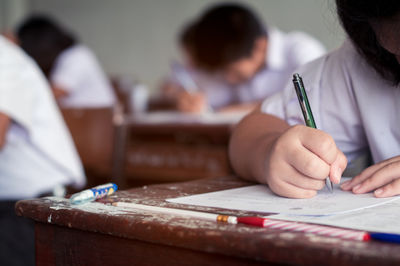Classroom Seating Setups

Classroom seating arrangements are just as paramount as any other an aspect of teaching and lesson management. An effective classroom seating arrangement or lack thereof can easily be the difference between an optimally performing class and a mediocre class. As a teacher, one needs to create a synergy between the chosen classroom setup and the teacher's style of teaching, the students' personalities, the classroom furniture and the classroom space itself. A host of factors influence the most effective classroom seating arrangements and some of which shall be discussed in this summary. It is also important to note is that some of these influential factors are so dynamic (may even change with every new day or new lesson) such that a teacher needs to remain flexible when it comes to accommodating new seating configurations.
Table of Contents
Space Available (Classroom Size and Shape)
Types of Sitting Configurations
Do you want to teach English abroad? You are on the right way. Take a TEFL course today!
This post was written by our TEFL certification graduate Marsha T. Please note that this blog post might not necessarily represent the beliefs or opinions of ITTT.
The configurations in which you organize the students' positions and that of yourself largely depends on, but not limited to, some of them factors listed below:
Listen to this blog post:
Space Available (Classroom Size and Shape)
The size and shape of a classroom, often times than not, will determine the variety of seating arrangements that can work within the space available. Certain seating configurations are not practical and may not work certain classroom shapes. For example, horseshoe/circular seating arrangements are unsuitable for classes being conducted from a room with a rectangular (long and narrow) floor plans.

Also Read: How much can I earn teaching English abroad?
Classroom furniture
The kind of classroom furniture greatly influences the kind of seating arrangements to be chosen. Chairs and desks that come as separate singular units allow for more and different seating configurations to be used.
Possible Attention Diversions
A teacher has to consider possible attention diversions (distractions) when choosing a preferred seating arrangement. Finding ways of reducing possible distractions may enhance students' attentiveness and increase classroom productivity. Where possible, the classroom seating arrangement should be such that things like windows overlooking busy car parks or a busy road should be kept out of the direct line of the sight of your students.
Student Age and Size
The age and the number of students in the class impact the seating arrangement. In deciding on sitting arrangements, a teacher should be mindful of the general behavioral patterns that are age-specific. For instance, it is not the same experience when one teaches adults compared to teaching teenagers and children. Children and teenagers tend to have more disruptive behaviors so your classroom seating arrangement should depend on the students that you have in your classes.

Also Read: The Influence of English on Globalization
Student Personality
A teacher may want to mix students of different personalities in order to boost classroom productivity. During group work activities, a teacher may choose to pair talkative students with quieter ones so as to encourage quieter students to participate more actively in class activities.
Lastly, and most importantly, the teacher's style of teaching and focus determines the seating configuration. Below listed are the three teaching styles explained and how they affect classroom seating configurations.
Teacher-focused Class:
If the teacher's style of teaching is more of a lecture/presentation kind of approach, the teacher may want to use a seating configuration where all students are able to see and hear the teacher whilst he stands in front of everyone. The teacher becomes the center of attention in this case.
Learner-focused Class:
If the teacher's style is one that encourages student-to-student interaction or group work, the teacher may want tofind a seating arrangement that encourages students to interact with one another and less with the teacher.
A combination of both: in many instances, teachers believe that a style of teaching that strikes a balance between both styles (Teacher-focused and Learner-focused Classes) is the most effective. In this case, a teacher should look for seating configurations that are flexible and functional.

Also Read: Teacher's Confidence in Different Types of Classrooms
Types of Sitting Configurations
Traditional Rows or Columns
This is the most commonly used classroom seating arrangement and is mainly based on Teacher-focused style of teaching and is suitable for all classroom sizes and shapes. This configuration has the advantages of minimizing disruptions among students, encourages individual work, it is the most effective for lectures/presentations and also easy for the teacher to supervise the class. This setup, despite its upsides, it may not work optimally for large classes. Large classes may often see uneven levels of interaction as students in the front row will participate more while those in the back may lose focus.
Circles/ Horse-shoe Setups
This configuration is best suited for student-to-student interaction and teacher-to-student interaction. This format is the one that strikes a fair balance between the Teacher-focused and the Student-focused style of teaching. Lessons that require discussions and presentations are the ones that mainly function well with this configuration. It is, however, difficult to control individual student behavior and enforce discipline with this layout.

Also Read: What You Need To Consider Before Planning Your Lessons
Separate Tables/ Group pods
Seating arrangements where students are clustered into small groups promote student-to-student interaction. Students develop skills such as communication, problem-solving and collaboration in this arrangement. Group seating arrangements offer safe and comfortable working spaces for students to explore tasks among themselves. This arrangement, however, encourages noise-making and distractions among students as well as presenting a challenge for the teacher when it comes to enforcing student discipline.
Do you want to teach English abroad? You are on the right way. Take a TEFL course today!
Having shown that Seating arrangements in the classroom can greatly influence learning outcomes, it is therefore important that a teacher chooses the classroom arrangement that supports his or her teaching style and objectives.
Apply now & get certified to teach english abroad!
Speak with an ITTT advisor today to put together your personal plan for teaching English abroad!
Send us an email or call us toll-free at 1-800-490-0531 to speak with an ITTT advisor today.



